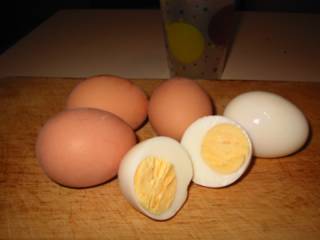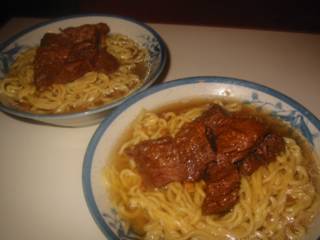 For years I used to dream of recreating this beef dish. This is the one we put as a topping on our Beef Mami (Beef Noodle Soup). It can be served as well on a bed of noodles without soup. It is also known as Beef Flank in Chinese restaurants. While living in Hong Kong, we would often speculate on the ingredients used whenever we have one from a restaurant or a hawker. It remained a dream until I stared long enough on one of the sections of the Chopsticks Recipes series cookbook (titled Quick Meals authored by Cecilia Au-Yeung). Suddenly I realised it was the one I've been searching for! I test cooked it and indeed it was the one! Eureka!
For years I used to dream of recreating this beef dish. This is the one we put as a topping on our Beef Mami (Beef Noodle Soup). It can be served as well on a bed of noodles without soup. It is also known as Beef Flank in Chinese restaurants. While living in Hong Kong, we would often speculate on the ingredients used whenever we have one from a restaurant or a hawker. It remained a dream until I stared long enough on one of the sections of the Chopsticks Recipes series cookbook (titled Quick Meals authored by Cecilia Au-Yeung). Suddenly I realised it was the one I've been searching for! I test cooked it and indeed it was the one! Eureka!
A tip on the recipe, try to buy bean paste/sauce where all the beans are pureed well. The one available to me has lots of whole beans in it and it's hard to mash before cooking since the beans are still quite firm. It's hard to do it after/during cooking as well because the pesky little beans are hard to catch and really so much trouble. So get the bean paste that's well mashed up.
Try to keep the ginger in one or several big lumps so it's easier to fish them out of the sauce for serving. I'm actually tempted to put all the spices in a tied up muslin bag to save me from straining the sauce. Maybe I'll do just that one of these days.
Braised Brisket of Beef
500 g stewing cuts of beef (brisket, chuck, shin, etc.) - cut into chunks
2 pcs star anise
1 square inch fresh ginger - peeled and mashed/sliced
1 square inch dried tangerine (or orange) peel [optional]
2 Tbsp cooking oil
5 cups boiling water (approximate)
1 tsp garlic - minced
2 tsp rice wine or dry sherry
1/4 cup ground bean paste/sauce
*Seasoning:
1 Tbsp rice wine or dry sherry
1/4 tsp salt
2 Tbsp sugar
1 Tbsp dark soy sauce
a pinch of pepper
*Gravy Mix:
1 tsp cornflour
1 Tbsp water
1 tsp sesame oil
- (Optional) Soak tangerine peel in warm water until soft.
- Wash and place brisket in a pressure cooker. Pour enough water to cover the brisket. Cover and pressure cook for 15 minutes.
- Remove beef and stock/sauce from the pressure cooker. Separate the beef from the stock and set aside.
- Heat the oil in medium heat in the pressure cooker pot and sauté the minced garlic, ginger, and ground bean paste until aromatic.
- Add the beef and stir fry for 2 minutes. Sprinkle wine. Stir fry for a few seconds.
- Strain the beef sauce (beef stock where the beef was cooked) into the pot. Add star anises, and tangerine peel (if using). Cover pressure cooker and bring to boil. Lower heat and simmer for 15 minutes.
- By this time the beef should be tender. Turn off heat and remove the lid once the pressure cooker has cooled down sufficiently.
- Stir in the seasoning and simmer for a further 5 minutes.
- Add gravy mix. Simmer for 2 minutes or until thick.
*Notes:
- Sometimes I do not pre-boil the beef. So I skip procedure nos. 2, 3, & 7 and soften the meat by simmering for a long time with the seasoning in a regular pot or through a crockpot/slow cooker.
- We mainly use the above recipe for beef mami. Just cook some egg noodles and put some chicken broth/stock, add the beef brisket and its sauce, then sprinkle some chopped green onions on top.

I have to do this post quick for our niece Dang who needs the recipe tonight. This is adapted from my most worn out cookbook (meaning a favourite and I do need a replacement since it's literally falling apart) - Let's Cook with Nora by Nora Daza. The recipe is titled Nena Zafra's Cassava Bibingka but I have to make a lot of adjustments because I find the cake too rich and the topping much richer still. So I toned it down a lot but left the topping as it is. I baked it in bigger pans and at longer time. Result? A best seller in every Pinoy gatherings and very popular at balot or pabaon time (the Pinoy predilection for having take-home bags of food upon leaving a Pinoy party - how's that for a double whammy?).
The cake is easy to make while for the topping, you do have to *constantly* stir the sauce while cooking because it burns very easily. Use the 'flour for sauce' for this one if you have access to it. Here in UK it is available in any supermarket flour section. I think it is formulated with less gluten so it will not form lumps when added to sauces. Which is heaven sent for us hapless cooks. It really does not form lumps as per my experience but still retaining all the thickening properties of a regular flour.Cassava Cake
7 cups [5 lbs/2.25 kg] grated cassava
3 eggs - beaten
1 1/2 cups sugar
1 tall can evaporated milk (410 gm)
1 tall can coconut milk (400 ml)
1 tall can water* (400 ml) - use the can of the coconut milk
1/4 cup melted butter
- Preheat oven at 350F/180C/gas mark 4.
- Mix all ingredients together well.
- Pour in a greased 13 x 9 inches pan or three 9-inch square pans.
- Bake for 1 hour or until a toothpick inserted in the middle comes out clean or with moist cassava instead of wet batter.
*Topping:
1 can condensed milk (397 gm)
1 cup coconut milk
2 Tbsp sugar
2 Tbsp flour
2 eggyolks - beaten
- Combine the first four ingredients in a heavy based saucepan and bring to boil while stirring constantly.
- When thick, remove from heat and pour the egg yolks in a thin stream. Make sure you are stirring quite fast otherwise the egg yolk will coagulate and would not blend well with the sauce.
- Bring back to low heat and cook for 1 minute, still stirring constantly.
- Spread on top of the cooked cassava cake and broil/grill at 400F/200C for about 5 minutes or until top is golden brown.
*Note: The reason why water is added is to dilute the coconut milk because most of the canned ones I buy here are very thick almost like coconut cream. So if your coconut milk is quite thin or the 'normal' one, then put in 2 x 400 ml of it.
In my opinion, the wing part of chickens has been neglected by Western cuisine. Trust a Chinese cook to make a lot of delectable dishes out of it. It's my favourite part. Whenever we have a roast chicken I always grab it to make sure no one else will have it. :-)
This recipe is a firm favourite of ours and a regular in our dinner table. Easy to make, just a few ingredients plus has vegetables for balance of flavour and nutrition. Plus the wings is probably the cheapest cut of poultry there is. Again, I adapted this from the Chinese Cuisine by Huang Su Huei.
Chicken Wings with Oyster Sauce
12 chicken wings (about 1 kg)
1-1/2 Tbsp soy sauce
oil for frying
1 green onion, cut into 6 pieces
6 slices ginger root
*Sauce:
2 Tbsp oyster sauce
1/4 tsp salt
1 tsp sugar
dash of black pepper
1 cup water
*Thickener:
1/2 Tbsp cornstarch
1 Tbsp water
1 bunch broccoli
- Cut and separate the wings at the joints, discard the tip or use for chicken stock. Clean the wings and pat them dry.
- Combine chicken wings and soy sauce in a bowl. Mix them well. Marinate for 20-30 minutes.
- While the wings are marinating, cut and separate the broccoli florettes. Wash well and steam for 3-4 minutes or until just about cooked. Line the sides of a serving plate with the cooked broccoli. Set aside.
- Heat wok then add oil. Deep fry wings until golden brown (about 5 minutes). Remove and set aside.
- Remove oil from the wok. Reheat the wok and add 1 Tbsp oil. Stir-fry the onions and ginger root until fragrant.
- Add wings and sauce; bring to boil. Lower heat, cover and simmer for about 5 minutes, or until liquid is reduced to 1/2 cup.
- Add thickener; stir until sauce has thickened. Dish up on the serving plate with broccoli. Serve.
Note: For the vegetables, you may use any steamed/cooked green vegetable such as pechay (pak choi), nappa cabbage (Chinese cabbage), regular cabbage, choi sum (Chinese broccoli), etc.

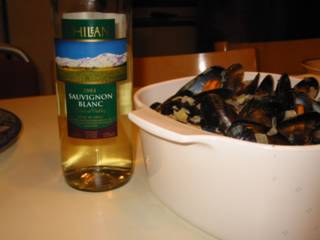 Here is my entry to the worldwide-web food event "Is My Blog Burning?" (IMBB). The eighth edition is hosted by Donna which features wine or spirits as a main cooking component of the dish. My contribution is a very simple tahong (mussels) with wine. I used a Chilean Sauvignon Blanc - don't ask me why I don't know anything about wines. I just asked my husband on what to use. This is adapted from a recipe in the fooddownunder.com website. I just simmered the wine a little bit longer to reduce the alcohol taste and added some salt and garlic. It turned out quite good, the freshness of the mussels standing out in the simplicity of the dish.
Here is my entry to the worldwide-web food event "Is My Blog Burning?" (IMBB). The eighth edition is hosted by Donna which features wine or spirits as a main cooking component of the dish. My contribution is a very simple tahong (mussels) with wine. I used a Chilean Sauvignon Blanc - don't ask me why I don't know anything about wines. I just asked my husband on what to use. This is adapted from a recipe in the fooddownunder.com website. I just simmered the wine a little bit longer to reduce the alcohol taste and added some salt and garlic. It turned out quite good, the freshness of the mussels standing out in the simplicity of the dish.
I saw an episode of a TV cooking program of Rick Stein wherein he goes to different coastal areas around the world. One time he was in a seaside village in Portugal and was adviced (looks more like ordered to me actually) by an old local man (who came in within camera range; not in the script at all) to cook the mussels in a covered pot for no more than 4 minutes. I followed that and I got tender cooked mussels, not rubbery at all. Thanks to the old man for the tip!
Mussels with Wine
1 kg fresh mussels
2 onions - chopped finely
3 cloves garlic - chopped finely
1 Tbsp butter
1 Tbsp olive oil
1 tsp freshly ground black pepper
1 cup white wine
1/2 tsp sea salt
- Heat butter and olive in a pot.
- When the butter starts to bubble, add in garlic and onion. Cook on medium heat until onion is translucent (about 5 minutes).
- Add salt and pepper. Stir and cook for about 1 minute.
- Add wine and bring to boil. Bring down to simmer and cook for about 5 minutes.
- Add mussels, stir a little, bring heat to high, cook covered for 4 minutes.
- Sprinkle parsley and serve.
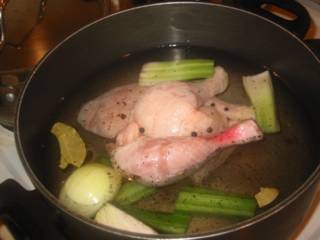 My family likes soupy dishes so more often than not I make chicken stock. The resulting stock liquid is made into either Almondigas, Sotanghon Soup, Chicken Macaroni Soup, or any other that requires chicken stock. Meanwhile the meat is either: flaked for chicken spread or salad, deboned and cut up for pancit, or deep fried for Crispy Fried Chicken.
My family likes soupy dishes so more often than not I make chicken stock. The resulting stock liquid is made into either Almondigas, Sotanghon Soup, Chicken Macaroni Soup, or any other that requires chicken stock. Meanwhile the meat is either: flaked for chicken spread or salad, deboned and cut up for pancit, or deep fried for Crispy Fried Chicken.
It is preferable to use the bony part of a chicken or even a whole one. The bonier the better. Some even suggest using 'old' chicken (as in not young) so as to maximise the flavour. In the picture above you can see all the ingredients for the stock.
Chicken Stock
1/2 to 1 kg bony part of chicken
1 Tbsp sea salt
1-2 bay leaves
1 tsp pepper corns
1 stalk celery - chopped into 1 inch pieces
1 medium onion - quartered
1 carrot - peeled and sliced into 1 inch pieces (optional)
8 cups water
- Combine all the above ingredients in a big pot. Bring to boil.
- Skim off any scum that comes up to the surface.
- Bring down heat to low and simmer for at least 1 hour.
- Remove and discard rendered fat/oil floating on the stock soup by any of the following methods:
- Skim off with a spoon
- Chill the stock in the fridge and skim off the congealed oil on top
- Use a gravy/stock oil separator jug
Chicken meat boiled, steamed, or poached before deep frying turn out to be more crispy than those that were not. For this next one, use the chicken meat from the Chicken Stock. You may cut them up into serving size pieces. The sauce is a very simple one (but very delicious I guarantee you) and is adapted from the Chinese Cuisine cookbook by Huang Su Huei. The chopped ginger and green onions are optional you can do away with it. Also the sauce may be served on the side like a dip.
Crispy Fried Chicken with Sauce
boiled chicken (from Chicken Stock)
*Sauce
2 1/2 Tbsp soy sauce
2 Tbsp vinegar
1 1/2 Tbsp sugar
1 tsp sesame oil
2 Tbsp chopped green onion (optional)
1 Tbsp ginger (optional)
- Deep fry chicken in oil heated to 180°C/350°F until crisp (about 3-4 minutes). Put in a serving plate.
- Stir the ingredients for the sauce until sugar is dissolved and pour over the fried chicken (or put on the side as a dip).
Enjoy!
Me and my work colleagues went on our bi-monthly night outs last Tuesday. This time we aimed to see the Shaolin Monks at the Peacock Theatre near Holborn tube station. We had drinks and dinner first at Belgo a bar/restaurant that serves Belgian beer exclusively. And lo and behold I got this beer:
 I should have taken a picture of the bottle as well just to prove that it's true. I was tempted to ask for the accompanying maid to serve me hand and foot. ;-) Taste of the beer is good - smooth, not as bitter as most beers served in UK pubs. They're a bit sweetish as well. Dinner food was okay especially since it's free on an expense account.
I should have taken a picture of the bottle as well just to prove that it's true. I was tempted to ask for the accompanying maid to serve me hand and foot. ;-) Taste of the beer is good - smooth, not as bitter as most beers served in UK pubs. They're a bit sweetish as well. Dinner food was okay especially since it's free on an expense account.
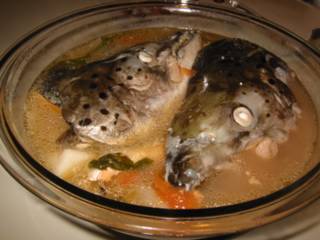 One look in the picture above and I thought "there are monsters in my soup!!". They look pretty sinister don't you think? But God help them once me and my husband have started the 'attack'. Only bones and fins were left. Sorry about the picture, you can hardly see any other condiments in it. The heads are so big they just overwhelmed everything else - the taro, spinach, etc.
One look in the picture above and I thought "there are monsters in my soup!!". They look pretty sinister don't you think? But God help them once me and my husband have started the 'attack'. Only bones and fins were left. Sorry about the picture, you can hardly see any other condiments in it. The heads are so big they just overwhelmed everything else - the taro, spinach, etc.
We had a chance to go to the nearby Chinese supermarket and I saw these big gorgeous salmon heads. Immediately my husband said sinigang! So I bought two for only £1 each and put all the other ingredients in our cart salivating on the thought of a sour sinigang when we get home.
Sinigang for you non-Filipinos is clear sour soup dish. It may contain any type of meat - beef, pork, fish, chicken with any combination of vegetables. I've seen Pinoys putting in broccoli and carrots. In HongKong I always put in mustard leaves. Since it is a soup, the bone-y parts of meat is preferable to use to give it more flavour. The sour taste come from a number of fruits - sampalok fruit (tamarind), sampalok young leaves, bayabas (guava), kamias (what's kamias in English?), among others. If you're not in Asia it can be a problem to get these so you can substitute with lemon or lime.
I remember very well the first time I got a salmon head from our local Tesco supermarket. I pointed to the salmon cabeza and told the shop assistant "I'll have those please." He proceeded to bag it and stick a barcode on it. He handed it to me, we said our thank yous and I tried looking at the price in that barcode label. There was none. I asked him how much is it. He said "It's okay it's free. By the way, how many cats do you have?" He thought it was for my non-existent cat !! I tried hard to compose myself not to laugh with the thought that he might take away my precious salmon head. I mumbled something about 2 cats and hurriedly left. I don't want to linger around trying to answer questions on the colour or whether it's male or female, etc. Sus! If he only knew who the 'cats' were ... hahaha!
Okay on with the show, fish (including their head) cooks very easily. You cannot cook it for more than 10 minutes or you will end up with luray-luray na isda (nuked fish). Do not overcook the fish because it's not appetising when it is. Since it cooks easily, it has to be one of the last ones in the pot. The chili is important to reduce the lansa (slimeminess) of the fish.
If you are using real fresh unripe sampalok fruit you have to wash it first to remove most of the brown powdery thing on its skin. Cook it with the onion and tomatoes or separately in another saucepan with some water. [For me, souring with sampalok is the best.] Once cooked, fish them out (the sampalok not the fish), put in a bowl with some water and mash them. This is what you will use as a souring agent - straining of course to exclude the skin and seeds. Or if you think this is all a big hassle you could do as I did - I bought a jar of Thai tamarind puree. Ta-da! Problem solved. I avoid using the sinigang powder mix because the sourness does not last when you reheat it. And I bet there's some synthetic chemicals in them, too. So let's all eat an all natural sinigang and use sampalok. If you can't find sampalok use lemon and/or lime.
Salmon Head Sinigang
1 or 2 salmon head
3-4 tomatoes - sliced
1 big onion - sliced
1 Tbsp rock salt
1-2 chilis (red or green) - pointed ends cut off
6-8 cups water or rice water*
souring agent (tamarind puree, lemon and/or lime)
1 aubergine (eggplant) - sliced 1 inch thick and quartered
1 bunch long string beans (sitaw) [optional] - cut into 2 inch pieces
2 taro roots (gabi) - peeled and quartered
spinach leaves or kangkong - washed and plucked from stems
- Have the fishmonger remove the gills and clean the salmon head. If you can have the head cut lengthwise so much the better.
- Combine tomatoes, onion, and rock salt in a big pot. Mix and mash them a little bit with your fingers. Add chilis.
- Pour just enough water to cover them and bring to boil. Cook for about 3 minutes. Mash the tomatoes with a sandok (cooking spoon).
- Pour in the rest of the water and add taro, aubergine and sitaw. Bring to boil and simmer until taro is almost cooked (about 5 minutes).
- Add fish head and cook for 5 minutes or until the fish meat is cooked.
- Add the souring agent and spinach (for tamarind puree I use about 3/4 cup of it). Cook for 1-2 minutes. Taste soup and adjust seasonings accordingly. Serve.
*Note: Rice water is the water used in washing rice. Save this when you cook rice. Obviously do this before preparing and cooking the sinigang.
I know, I know, you must have thought this is a no-brainer. Well my children don't know how to do it properly yet so please indulge me in setting their boiling knowledge straight.
Now the thing about hard boiling eggs is not to boil them but to simmer them to minimise the cracking of the shell. Bring them to rolling boil and then turn the heat way low and simmer. Also the choice of eggs is important. You should use eggs that are about a week old. Fresh eggs when hard boiled are quite hard to peel. Other people pierce one end of the eggs I think to make the yolk stay in the centre (I'm not so sure about that). They also should preferably be in room temperature to reduce cracking. The greater temperature changes it goes through in a short span of time the greater the chances of cracking.
To Boil an Egg
* Method 1:
- Put room-temperature eggs in a saucepan and add enough water to cover them.
- Bring to boil. Once it boils, cover (if it is not yet covered) the saucepan. Turn off heat and begin timing.
- For hard-boiled - let stand in saucepan for 10-12 minutes depending on the size of the eggs.
- Drain water from saucepan and fill-up with cold tap water. Keep it submerged for about 5 minutes or until cool enough to handle. Drain cold water and serve boiled eggs hot or cold.
* Method 2:
- Put eggs in a saucepan and add enough tap water to cover them by about 1/2-inch.
- Bring to boil. Once it boils begin your timing; turn down heat to low and simmer.
- For hard boiled - simmer for 10 minutes. Cook for less time if you want the centre more squidgy.
- For soft boiled - simmer between 3 - 5 minutes. The less time you cook the softer the boiled egg will be.
- Remove from saucepan and submerge completely into a container with cold tap water (or drain the hot water from the saucepan and fill it up with cold tap water). Keep it submerged for about 5 minutes draining and refilling again if the water becomes quite hot. This submersion is done to stop the egg from further cooking. If you cooked soft boiled eggs and did not cool it down immediately you could well end up with hard boiled eggs.
* Method 3:
- Keep eggs chilled in the fridge.
- Bring a saucepan with water to a boil (make sure the water is enough to cover the eggs).
- Lower the chilled eggs straight from the fridge. Start timing at this point.
Bring the water to a simmer and cover.
Timings: - 14 minutes - hard boiled
- 12 minutes - hard boiled with a little soft spot centre
- 10 minutes - hard boiled with gooey middle
- 8 minutes - fully set white and yolk with soft gooey middle
- 6 minutes - soft boiled with firm white, yolk starting to set
- 5 minutes - soft boiled with firm white, runny yolk
- 4 minutes - soft boild with very soft white and yolk
I adapted this last method from an Epicurious article with excellent tips as well on how to quickly peel eggs. Apparently, boiling eggs straight from the fridge helps a lot in being able to peel eggs easily.
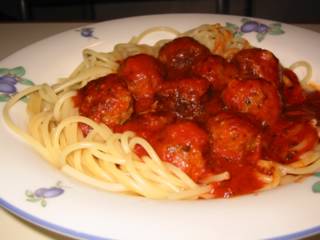
spaghetti meatballs
This is one of my son's favourite (he likes anything with pasta) which we had about a week ago. I finally persuaded him to do it by himself. I armed him only with the recipe and all the ingredients. And he did it ! Well done! Although as expected after he was finished our kitchen looked like a bombsite. Sauce splattered everywhere, bits of onion and garlic on the floor, pots and pans galore plus a mountain of things to wash in the sink. Haay naku, at least he's not as useless in the kitchen as his dad ;-).
Okay on with the recipe, the key here is to keep the size of the meatballs small. Make it no bigger than a conker (about 3/4 to 1 inch in diameter). The bigger the meatball the tougher it tends to be. And it's easier to keep the ball's shape when it's small. I baked the meatballs to minimise oil but you can always pan fry it.
Spaghetti Meatballs
*For the meatballs:
500 g minced beef
2 slices of white bread - crusts removed
5 Tbsp milk
3 Tbsp grated parmesan cheese
2 Tbsp finely chopped parsley or 1 Tbsp dried parsley
1 tsp sea salt
1 egg - slightly beaten
freshly ground pepper
*For the sauce:
1 Tbsp minced garlic
1 medium onion - finely chopped
1/8 tsp dried chili flakes
1 Tbsp dried mixed herbs
1 tsp sea salt
2 x 400 g cans chopped tomatoes
*Make the meatballs:
- Tear apart sliced bread. Soak in milk for about 30 minutes or until bread is completely soft. (You can also use an equivalent amount of breadcrumbs). Mash it with your fingers.
- Combine beaten eggs, salt, and pepper.
- Add in minced beef, parsley, softened bread, and parmesan cheese. Mix well.
- Form into balls of about 3/4 to 1 inch in diameter. (One technique in making the balls - put some meat mixture on your palm; make a fist and then let the meat come out between your forefinger and thumb).
- Put meatballs on a baking tray and bake in 350F for about 5 minutes or you can pan fry them until browned. Transfer to a bowl/plate and set aside.
*Make the sauce:
- Saute the garlic and onion in a pot until onion is translucent.
- Add the chili flakes and saute for about 1 minute.
- Add the mixed herbs and saute for another minute.
- Pour in the chopped tomatoes, salt, and meatballs. Mix well.
- Bring to boil and simmer for 1 hour. Add water a little bit at a time if it is drying out too much or if you want more sauce.
*For the pasta:
- Put water in a big pot (enough for the pasta to swirl around - about 2/3 up the side of the pot). Add 1 tsp. salt. The salt is to keep the water from boiling over too much.
- Bring to boil then add the spaghetti. Start timing now. Follow the timings suggested on the pasta package. This is usually 11 minutes for regular spaghetti or tagliatelli and 9 minutes for the quick cooking ones. Stir pasta from time to time.
- Pour and drain cooked spaghetti into a colander (not plastic!). Briefly put under tap water; this is to remove excess starch - drain again. *Update* I don't put oil any more after draining since you want the sauce to cling to the pasta not slide off.
*Serve meatballs with sauce on top of spaghetti. Grate more parmesan cheese on top if desired.
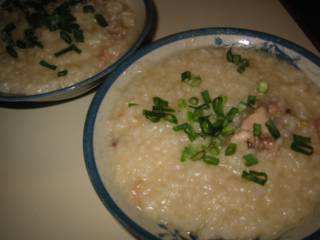 Usually when I'm ill, feeling very down, and just want to sleep all day I often want to have one of my favourite comfort food - lugaw. It's also called a number of different names like - pospas, porridge, congee, and arroz caldo. Nothing beats the smell and taste and satisfaction of eating it while your nose is drooling from a bad cold or flu. If it's for someone with a stomach upset you cook and serve it without oil or meat. Normally the meat that accompanies the Filipino version is goto (beef tripe) or chicken. Since I do not want to spend a lot of time cooking it I often do the chicken version. It takes time to tenderise the beef tripe, you know.
The malagkit (glutinous rice) in the recipe is optional. It is added to make the soup a bit thicker. Another optional ingredient is the kasubha I think this is the Pinoy equivalent of saffron. It makes the lugaw a bit reddish/yellow which is not really essential and does not add much taste to it. And finally, the variation of adding vegetables came from my mother-in-law. It's not to everyone's liking although I love eating chunks of veggies in the lugaw. Slurp slurp ... aaahhhh!
Lugaw with Chicken
Usually when I'm ill, feeling very down, and just want to sleep all day I often want to have one of my favourite comfort food - lugaw. It's also called a number of different names like - pospas, porridge, congee, and arroz caldo. Nothing beats the smell and taste and satisfaction of eating it while your nose is drooling from a bad cold or flu. If it's for someone with a stomach upset you cook and serve it without oil or meat. Normally the meat that accompanies the Filipino version is goto (beef tripe) or chicken. Since I do not want to spend a lot of time cooking it I often do the chicken version. It takes time to tenderise the beef tripe, you know.
The malagkit (glutinous rice) in the recipe is optional. It is added to make the soup a bit thicker. Another optional ingredient is the kasubha I think this is the Pinoy equivalent of saffron. It makes the lugaw a bit reddish/yellow which is not really essential and does not add much taste to it. And finally, the variation of adding vegetables came from my mother-in-law. It's not to everyone's liking although I love eating chunks of veggies in the lugaw. Slurp slurp ... aaahhhh!
Lugaw with Chicken
500 g chicken - cut into bite-sized pieces
1 cup rice
1 Tbsp glutinous rice [optional]
2 Tbsp fish sauce (patis)
8 cloves garlic - minced
1 medium onion - chopped
1 square inch of ginger root - julienned
8 cups water or chicken stock
2 Tbsp oil
2 stalks green onion - chopped
chopped vegetables [optional]
pinch of kasubha (saffron) [optional]
- Heat oil in a big pot or saucepan.
- Saute garlic in low heat (so it will not burn) for a few seconds.
- Increase heat to medium and stir in onion and ginger until aromatic (about 1-2 minutes).
- Add chicken and patis, stir for a seconds then cover and simmer for about 5 minutes turning the chicken once in a while.
- Stir in all the rice and mix with the chicken and patis mixture.
- Add in the water and bring to boil while stirring the bottom from time to time to prevent the rice from sticking.
- Turn down heat to low and simmer for at least 45 minutes or until chicken is cooked and the soup is thick. Stir occassionally making sure the rice does not stick at the bottom of the pot.
- [Optional] At this point you can add chopped vegetables of your choice to the pot and cook until they are done. Favourites are broccoli, carrots, peas, etc.
- Ladle into bowls; sprinkle chopped green onion, kasubha, and fried garlic on top. Serve with lemon or calamansi juice and more patis.
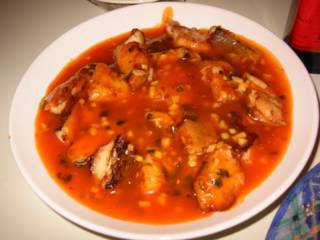 I got half kilo of haddock fillet from ASDA (a local supermarket) at half price! You know me I can't resist a bargain especially one that we really like. So off I go and try to make a good satisfying dish out of it. This recipe is from the book Chinese Cooking for Beginners by Huang Su-Huei. It is one of my favourite cookbooks and you can see the evidence from the worn out look of it.
I got half kilo of haddock fillet from ASDA (a local supermarket) at half price! You know me I can't resist a bargain especially one that we really like. So off I go and try to make a good satisfying dish out of it. This recipe is from the book Chinese Cooking for Beginners by Huang Su-Huei. It is one of my favourite cookbooks and you can see the evidence from the worn out look of it.
Despite the name of the dish it is not spicy hot - just a little bit very mild actually. The recipe calls for 300 gm of fish but I got double that so I doubled the measurements. It turned out there was too much sauce as you can see from the picture. So if you try this and have 500 - 600 gm fish just do a 1 1/2 of the recipe not double. But then again if you like the sauce it wouldn't be a problem, isn't it?
I only pan fried the fish instead of deep frying as stated in the book. I asked the hubster to take over the frying and he ended up not dipping it in the batter. He fried almost half of it with no batter! Haay naku ! Anyways it's a good thing it still tasted good.
Spicy Fish Fillet
2/3 lb (300 g) fish fillet
2 Tbsp oil
*Marinade:
1/2 Tbsp cooking wine
1/3 tsp salt
*Light batter:
1 egg
4 Tbsp cornstarch (cornflour)
3 Tbsp water
*Mixture 1:
1 1/2 Tbsp chopped green onions
1 Tbsp chopped ginger root
1/2 Tbsp minced garlic clove
*Mixture 2:
1 Tbsp cooking wine
3 Tbsp ketchup
1 tsp hot chilli paste
*Mixture 3:
3/4 cup water
1 Tbsp sugar
1/2 Tbsp cornstarch
3/4 tsp salt
- If the fish meat is thick, slice it lengthwise. Cut the fish meat into small steaks or fillets (about 1 1/2 inches x 1 inch).
- Add marinade, and set aside for 20 minutes.
- Mix light batter mixture and set aside.
- Heat the wok then add oil.
- Dredge the fish in the batter mix.
- Deep-fry (or pan fry) the fish over medium heat for 3 minutes or until the fish is thoroughly cooked and the outside is crispy. Transfer to a serving platter.
- Remove the oil from the wok.
- Reheat the wok then add 2 tbsp. oil.
- Stir-fry mixture 1 until fragrant.
- Add Mixture 2 and stir-fry for a few seconds.
- Add Mixture 3, bring to a boil then pour over the fish. Serve.








